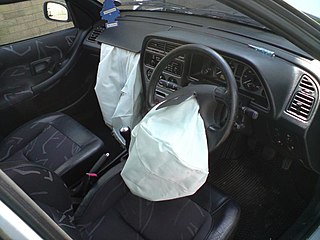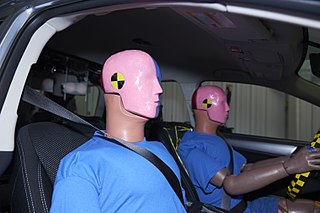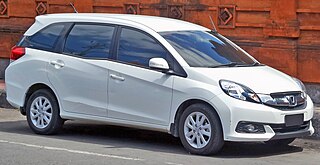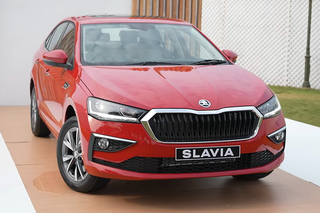Related Research Articles

An airbag is a vehicle occupant-restraint system using a bag designed to inflate in milliseconds during a collision and then deflate afterwards. It consists of an airbag cushion, a flexible fabric bag, an inflation module, and an impact sensor. The purpose of the airbag is to provide a vehicle occupant with soft cushioning and restraint during a collision. It can reduce injuries between the flailing occupant and the vehicle's interior.

A crash test dummy, or simply dummy, is a full-scale anthropomorphic test device (ATD) that simulates the dimensions, weight proportions and articulation of the human body during a traffic collision. Dummies are used by researchers, automobile and aircraft manufacturers to predict the injuries a person might sustain in a crash. Modern dummies are usually instrumented to record data such as velocity of impact, crushing force, bending, folding, or torque of the body, and deceleration rates during a collision.

Crumple zones, crush zones, or crash zones are a structural safety feature used in vehicles, mainly in automobiles, to increase the time over which a change in velocity occurs from the impact during a collision by a controlled deformation; in recent years, it is also incorporated into trains and railcars.

A crash test is a form of destructive testing usually performed in order to ensure safe design standards in crashworthiness and crash compatibility for various modes of transportation or related systems and components.

Automotive safety is the study and practice of automotive design, construction, equipment and regulation to minimize the occurrence and consequences of traffic collisions involving motor vehicles. Road traffic safety more broadly includes roadway design.

A bumper is a structure attached to or integrated with the front and rear ends of a motor vehicle, to absorb impact in a minor collision, ideally minimizing repair costs. Stiff metal bumpers appeared on automobiles as early as 1904 that had a mainly ornamental function. Numerous developments, improvements in materials and technologies, as well as greater focus on functionality for protecting vehicle components and improving safety have changed bumpers over the years. Bumpers ideally minimize height mismatches between vehicles and protect pedestrians from injury. Regulatory measures have been enacted to reduce vehicle repair costs and, more recently, impact on pedestrians.

The European New Car Assessment Programme is a European voluntary car safety performance assessment programme based in Leuven, Belgium. Formed in 1996, the first results were released in February 1997. It was originally started by the Transport Research Laboratory for the UK Department for Transport but later backed by several European governments, as well as by the European Union (EU). Their slogan is "For Safer Cars".

The Acura MDX is a mid-size luxury crossover SUV with three-row seating produced by the Japanese automaker Honda under its luxury Acura division since 2000. The alphanumeric moniker stands for "Multi-Dimensional" luxury. It has ranked as the second-best selling mid-size luxury SUV after the Lexus RX in the U.S.

The Acura RL is a full size luxury car that was manufactured by the Acura division of Honda for the 1996–2012 model years over two generations. The RL was the flagship of the marque, having succeeded the Acura Legend, and was replaced in 2013 by the Acura RLX. All models of the Legend, RL and RLX lines have been adapted from the Japanese domestic market Honda Legend. The model name "RL" is an abbreviation for "Refined Luxury."

The Insurance Institute for Highway Safety and Highway Loss Data Institute (IIHS-HLDI) is an American nonprofit organization. It was established in 1959, and it is noted for its safety reviews of vehicles in various simulated traffic situations, including the effectiveness of a vehicle's structural integrity and safety systems during a collision, in addition to examining improvement on such elements.

A side collision is a vehicle crash where the side of one or more vehicles is impacted. These crashes typically occur at intersections, in parking lots, and when two vehicles pass on a multi-lane roadway.

The Honda Mobilio is a seven-seat mini MPV produced by the Japanese automaker Honda. The first-generation Mobilio that was produced from 2001 to 2008 and sold exclusively in Japan. It was the second model in Honda's "Small Max" series and also took Honda's Global Small Platform and their i-DSI engine. In May 2008, the Freed was introduced, replacing the first-generation model. The second-generation Mobilio, which is based on the Brio, was introduced in September 2013 and went on sale in January 2014 for several emerging markets.

A collision avoidance system (CAS), also known as a pre-crash system, forward collision warning system (FCW), or collision mitigation system, is an advanced driver-assistance system designed to prevent or reduce the severity of a collision. In its basic form, a forward collision warning system monitors a vehicle's speed, the speed of the vehicle in front of it, and the distance between the vehicles, so that it can provide a warning to the driver if the vehicles get too close, potentially helping to avoid a crash. Various technologies and sensors that are used include radar (all-weather) and sometimes laser (LIDAR) and cameras to detect an imminent crash. GPS sensors can detect fixed dangers such as approaching stop signs through a location database. Pedestrian detection can also be a feature of these types of systems.
Honda Advanced Technology is part of Honda's long-standing research and development program focused on building new models for their automotive products and automotive-related technologies, with many of the advances pertaining to engine technology. Honda's research has led to practical solutions ranging from fuel-efficient vehicles and engines, to more sophisticated applications such as the humanoid robot, ASIMO, and the Honda HA-420 Honda-jet, a six-passenger business jet.

The Acura TLX is a four-door entry-level luxury sedan sold by Acura, a luxury division of Honda, since 2014. It is the successor to both the TL and TSX models. As of 2021, the discontinuation of the RLX leaves the TLX as the flagship sedan in Acura's lineup.
The C-NCAP is a Chinese car safety assessment program. It is primarily modeled after safety standards established by Euro NCAP and is run by the China Automotive Technology and Research Center. The C-NCAP was first run in 2006 and has been updated every three years since, with new revisions for 2009, 2012, 2015, 2018, 2021 and 2024.
Adrian Hobbs is a British safety expert specializing in automobile crashworthiness with a background in accident and injury investigation/analysis.
GlobalNew Car Assessment Programme is a project of the Towards Zero Foundation, a UK-registered charity. The programme serves as an umbrella organisation encouraging co-operation between the various New Car Assessment Programmes around the world, and a consumer test for vehicle safety in markets that are weakly regulated or do not yet have their own consumer safety programmes.

The Škoda Slavia is a subcompact sedan (B-segment) manufactured by Škoda primarily for the Indian market. It was introduced in November 2021 and has been produced since 2022. Built on the MQB A0 IN platform adapted for India, the vehicle is based on the Volkswagen Virtus sedan. The Slavia replaced the Volkswagen Polo-based Rapid.
Fiat ESVs are a small series of prototypes built by Fiat in the early 1970s, intended for research on passive safety features.
References
- ↑ "Corporate Milestones". Honda Worldwide. 2015-03-09. Archived from the original on 2015-03-09. Retrieved 2023-09-09.
- Honda R&D Co. Ltd. Corporate Milestones
- Honda Introduces New Crash Compatibility Body Frame Structure That Both Enhances Self Protection and Reduces Aggressivity [ permanent dead link ]
- Safety for Everyone
- Honda CSR report 2006
- Honda Introduces New Crash Compatibility Body Frame Structure
- Honda Technology Picture Book
- Civic Type-R Press Release
- Honda Inspire Press Release